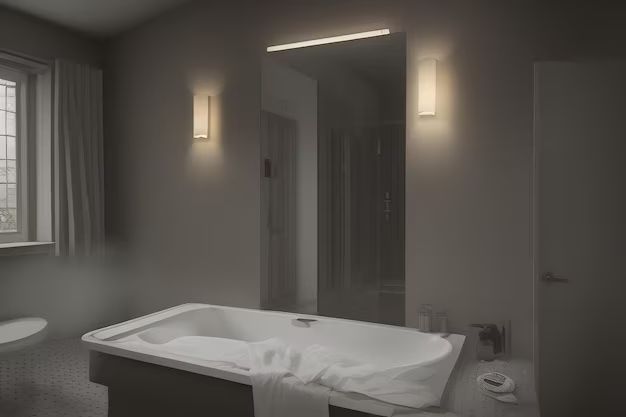Putting a light fixture directly above a shower or tub is generally not recommended, as moisture and steam can damage electrical components. However, there are ways to safely install lighting in this location if desired.
Page Contents
Requirements for Installing Lights Above Showers
If you want to install a light directly over a shower or tub, it’s important to follow safety precautions and meet electrical code requirements. Here are some key things to consider:
- Use a fixture labeled for damp locations – Choose a light fixture designed specifically for humid environments, clearly labeled as damp or wet location rated.
- Have a GFCI outlet – The light must be powered from a GFCI (ground fault circuit interrupter) outlet to prevent shocks.
- Maintain clearance – The bottom of the light fixture should be at least 8 feet above the top of the shower rim or tub.
- Avoid in-use covers – Do not use fixtures with in-use covers that close off the light when not in use.
- Moisture-sealed design – The fixture should have a moisture-sealed design to prevent water intrusion.
- Proper installation – Hire an electrician to install the light to ensure proper wiring and sealing.
Adhering to these guidelines helps reduce the risks of electrical hazards and damage to the light. Be sure to consult your local building codes as well, as some areas may have additional restrictions.
Choosing a Suitable Light Fixture
Here are some good options to consider when selecting a light to install directly above a shower or bathtub:
Vaporproof Ceiling Lights
Vaporproof or vapor-tight lights are designed to prevent moisture ingress. They have a rugged housing sealed with gaskets and silicone. Look for solid brass or stainless steel rather than plastic parts. Vaporproof LED lights provide bright illumination while being water- and corrosion-resistant.
Flush Mount Ceiling Lights
Flush mount fixtures sit directly against the ceiling. Choose an option rated for damp locations with a covered design that won’t allow water to pool. Avoid open bottoms that can let moisture in. Flush mounts come in simple round or square shapes.
Recessed Can Lights
Recessed can lights range from 4 to 6 inches in diameter. The recessed design helps prevent moisture from collecting on the fixture. Use IC-rated (insulation contact) cans that are properly sealed. Make sure the trim and lens are damp location rated.
LED Strip Lights
Waterproof LED strip lights provide a modern look. Choose strip lighting rated IP65 or higher to resist moisture. Install them carefully to prevent gaps where water could enter. Diffused lens covers help reduce glare. Strip lights give a nice glow but usually don’t provide task lighting.
Installation Tips and Precautions
Proper installation is crucial when placing lighting in a wet area. Here are some key precautions to take:
- Turn power off – Shut off electricity at the breaker before starting work.
- Follow dimensions – Adhere to all height and clearance requirements.
- Make it secure – Mount the fixture securely to framing members, not just to drywall.
- Seal openings – Caulk around openings with silicone to prevent moisture entry.
- Use roof jack – If wiring from above, install a roof jack to protect wire entry point.
- Ground properly – Connect ground wire to grounding screw or green ground lead.
- Keep wires dry – Leave 6-8 inches of extra wire length to prevent water travel.
Taking the time to properly seal and mount the light will help ensure safety and prevent premature failure. Consider having an electrician handle the installation if you are uncomfortable working with electrical wiring.
Maintenance Tips
Regular maintenance helps your shower light last longer. Follow these tips:
- Inspect seals – Check for cracks or gaps in gaskets and caulking that could let moisture in.
- Clean glass and lenses – Use a microfiber cloth to gently clean and remove dust and grime.
- Check wires – Examine wire connections for corrosion and replace if damaged.
- Test GFCI – Press the test and reset buttons monthly to ensure proper function.
- Consider floodlights – Replace floodlights or bulbs promptly when they burn out.
- Check for damage – Contact an electrician if you notice any cracked housing, parts, or melted wires.
Regular inspections and testing help maximize light lifespan and catch any potential electrical hazards before they become a problem. Contact a professional electrician for any major repairs needed.
Types of Lights Not Recommended
Here are some types of light fixtures you should avoid installing directly above showers or tubs:
| Light Type | Reason to Avoid |
|---|---|
| Non-IC recessed lights | Standard recessed lights allow contact with insulation which is a fire hazard in damp locations. |
| Junction boxes | Exposed connections could short and poses a shock risk with moisture exposure. |
| Wall mount fixtures | Risk of water running down into fixture along the wall. |
| Ceiling fans | Exposed wiring and fan blades produce greater hazards around water. |
| Hanging pendants | Dangling parts like pull chains increase risks of moisture collection and damage. |
| Incandescent bulbs | Incandescent lights produce more heat which accelerates deterioration in wet areas. |
Sticking with rated vaporproof or damp location fixtures minimizes risks. Check your chosen light to ensure it has the proper ratings before installing above shower or tub areas.
Conclusion
Installing lighting directly above a shower or bathtub can provide better illumination to the space. However, it also produces electrical safety challenges due to the presence of water. To safely add a light in this location, be sure to select a fixture designed for damp environments, have it installed properly on a GFCI circuit, and perform regular inspections. With the right precautions, you can safely brighten up your shower area with an overhead light source.
